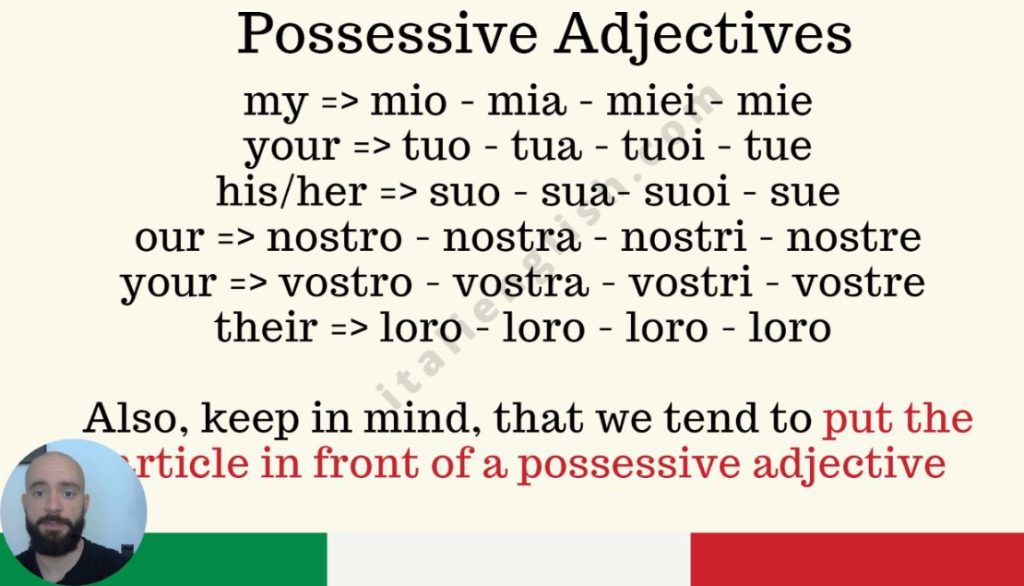Possessive adjectives play a pivotal role in language, enabling us to convey ownership and establish connections between individuals and objects.
In this blog post, we’ll delve into the world of Italian grammar, exploring possessive adjectives, their usage, and how they interact with gender and number in the Italian language.
Whether you’re an Italian language enthusiast, a student, or simply curious about linguistics, this guide will equip you with a solid understanding of possessive adjectives in Italian.
Content
Understanding Italian Possessive Adjectives: An Introduction
Possessive adjectives are words that illustrate ownership, indicating who possesses a particular item or entity. In English, these adjectives include “my,” “your,” “his,” “her,” “our,” “their,” and “its.” Similar to English, Italian possessive adjectives serve the same purpose – highlighting possession. Let’s break down these adjectives and their Italian counterparts using the valuable insights from the transcript.
- My (Mio, Mia, Miei, Mie): In Italian, the possessive adjective “my” translates to “mio” (masculine singular), “mia” (feminine singular), “miei” (masculine plural), and “mie” (feminine plural). For example, “My house is big” becomes “La mia casa è grande.”
- Your (Tuo, Tua, Tuoi, Tue): The Italian possessive adjective “your” corresponds to “tuo” (masculine singular), “tua” (feminine singular), “tuoi” (masculine plural), and “tue” (feminine plural). For instance, “Your hat is cold” translates to “Il tuo cappello è freddo.”
- His/Her (Suo, Sua, Suoi, Sue): “His” and “her” are both translated as “suo” in Italian. The form “sua” is used for feminine singular, while “suoi” and “sue” apply to masculine and feminine plural, respectively. For example, “Her car is red” becomes “La sua macchina è rossa.”
- Our (Nostro, Nostra, Nostri, Nostre): To express possession by “our,” the Italian forms are “nostro” (masculine singular), “nostra” (feminine singular), “nostri” (masculine plural), and “nostre” (feminine plural). As in “Our house is beautiful,” which is translated as “La nostra casa è bella.”
- Your (Vostro, Vostra, Vostri, Vostre): “Your” in the plural form can be translated as “vostro” (masculine singular), “vostra” (feminine singular), “vostri” (masculine plural), and “vostre” (feminine plural). For instance, “Your bikes are fast” becomes “Le vostre biciclette sono veloci.”
- Their (Loro, Loro, Loro, Loro): The Italian possessive adjective for “their” remains consistent regardless of gender or number. An example is “Their house is nearby,” which is “La loro casa è vicino.”
The Role of Articles with Italian Possessive Adjectives
One critical aspect of using possessive adjectives in Italian is the presence of articles. Unlike English, where we don’t typically use articles with possessive adjectives (e.g., “my car”), Italian requires an article before the possessive adjective (e.g., “la mia macchina”). This practice adds specificity and clarity to the ownership.
For instance, consider “my car is red.” In Italian, it becomes “La mia macchina è rossa,” where the article “la” (the) is placed before the possessive adjective “mia” (my) to indicate ownership of a specific car.
Do you like what you’ve read so far? Wanna grab a FREE 4-videos series? Subscribe to my newsletter!

I’ll notify you of new articles and send exclusive content. Don’t worry! No spam, no unwanted emails, and no sharing your data with third parties.
